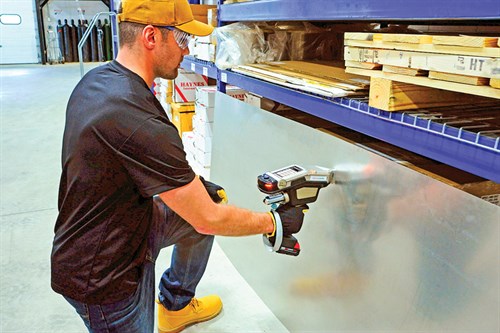Mitigate pipeline corrosion by prioritizing positive material identification
In the oil and gas industry, the emphasis on safety and quality assurance of assets at the worksite is always top of mind. Fatal accidents and injuries, as well as leaks and premature pipe replacements, are unfortunate consequences of failures that are often caused by faulty or misidentified metal assets. To mitigate the risk of these assets making their way onto the worksite, inspecting metals has become a regular practice that can ultimately reduce the risk of potential malfunctions or compliance issues.
Positive material identification (PMI) is an essential quality assurance step needed to avoid pipe corrosion, which is a leading cause of pipeline failures and leaks. PMI involves analyzing metals and alloys used in the manufacturing of assets such as gaskets, valves and piping, and helps ensure the integrity of infrastructure throughout the worksite.
With the oil and gas business being a high-hazard industry with numerous potential exposures to risk in all operations, the importance of PMI in pipeline integrity cannot be overlooked.
Why is PMI essential? Industry reported data suggests that as much as 3% of rogue material will make its way into critical process equipment. This can occur due to a number of factors, including a fabricator using unmarked and unknown material, a warehouse stocking inventory in the wrong location, a welder or pipefitter selecting the wrong component during the fabrication process, etc.
Along with vulnerabilities to rogue materials, oil and gas pipeline networks are susceptible to mechanical failures due to age and corrosion. When these pipes crack and leak, the results can be disastrous. Actively practicing PMI on existing piping equipment and assets entering the worksite can provide assurance that the correct metal alloys are being used, and allow inspection personnel to better understand and predict other wear and tear that may occur (FIG. 1).
 |
| FIG. 1. An inspector uses a handheld LIBS analyzer to analyze incoming materials. |
PMI and corrosion. According to the Pipeline and Hazardous Materials Safety Administration (PHMSA), corrosion is historically one of the two most prevalent causes of pipeline failures, making the requirement for PMI in alloys used throughout the plant more critical than ever. In fact, according to the National Association of Corrosion Engineers, the total annual cost of corrosion in the oil and gas production industry is estimated at $1.372 B.
Simply relying on spot testing of parts and subassemblies can be seen as too risky, which is why there has been an increase in the need for portable X-ray fluorescence (XRF) and laser induced breakdown spectroscopy (LIBS) analyzers. These analyzers play an essential role in PMI, particularly when analyzing the likelihood of corrosion, which is most commonly caused by several factors:
- Sulfidation: Also known as sulfidic corrosion, sulfidation continues to be a significant cause of leaks and problems in the refining industry that can lead to early replacements, unplanned outages and incidents potentially resulting in loss of property and injury to workers. Sulfidation corrosion occurs in carbon steel and low-alloy steel equipment when they are exposed to hydrocarbons containing sulfur compounds at elevated temperatures. Sulfidation corrosion thins the pressure boundary wall that contains the hydrocarbon and, if not addressed, can result in leakage to the atmosphere. This corrosion has proven to be higher in carbon steels containing less than 0.1% silicon. Therefore, it is important for refineries and other petrochemical manufacturers to be able to measure the silicon content of pipes, piping components and vessels in accordance with API Recommended Practice 939-C.
- Flow acceleration: Flow-accelerated corrosion, or FAC, occurs when carbon steel piping and components are degraded in the presence of flowing water or steam water with low-dissolved oxygen. FAC is the dissolution of the normally protective oxide layer on the inside surface of carbon and low-alloy-steel piping. This process results in the thinning of the pipe wall, which can then lead to leaks and potential catastrophic ruptures that can impact both worker safety and plant reliability. It has been widely demonstrated that small quantities of alloying elements, chromium in particular, greatly reduce the rate of FAC.
As a result, it has become an industry convention when inspecting for FAC to closely monitor trace alloy content. - Microalloyed steels: Microalloyed steels, often referred to as high-strength low-alloy steels (HSLA), are a family of materials strengthened by the addition of “micro” alloy concentrations to low-carbon mild steel. Microalloyed steels are used in every major steel market sector in various parts of the world, and their development has played an important role in the expansion of certain key industries, including the oil and gas industry. Although the strengthening effects of these elements make microalloyed steels particularly suited for high-strength applications, they can also detract from desired qualities such as toughness, ductility and weldability. It is essential that microalloyed steels are analyzed to verify that steel has the right levels of trace elements, such as niobium, vanadium and titanium; otherwise, there is a greater chance of corrosion, particularly if faulty or counterfeit metals are used (FIG. 2).

FIG. 2. An inspector uses a handheld LIBS analyzer to identify metal asset.
By understanding the different catalysts for corrosion, inspection personnel can use the technologies available to them to provide more context to the insights coming from PMI, allowing them to make more appropriate decisions around how best to manage the assets throughout the worksite.
Gain a better understanding of your pipelines. Pipeline malfunctions can occur in countless ways, but having a keen understanding of the risks of corrosion—and the role PMI can play in mitigating it—is critical to a safer worksite. By taking the time to introduce tools such as an XRF or LIBS analyzer into routine safety checks, inspection personnel will be able to accurately identify metal composition to ensure they are properly prepared.
An effective PMI program helps inspection personnel gain a better understanding of the assets throughout the worksite, allowing them to properly maintain or address any signs of corrosion, thereby remaining one step ahead of the risk of disastrous and hazardous pipeline malfunctions. GP
 |
BRIAN DALTON is the Product Manager for the newly launched Thermo Scientific Niton Apollo handheld LIBS analyzer. For the past 10 yr, Mr. Dalton has been actively involved in the development and commercialization of handheld XRF, LIBS and OES analyzers.




Comments